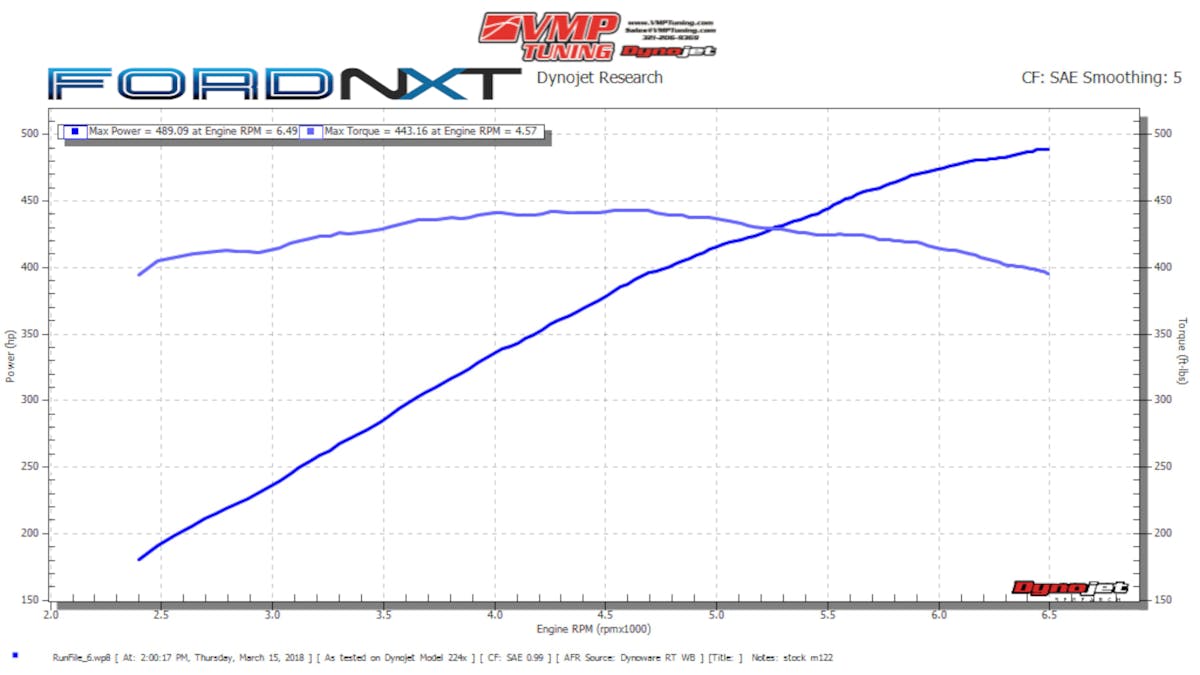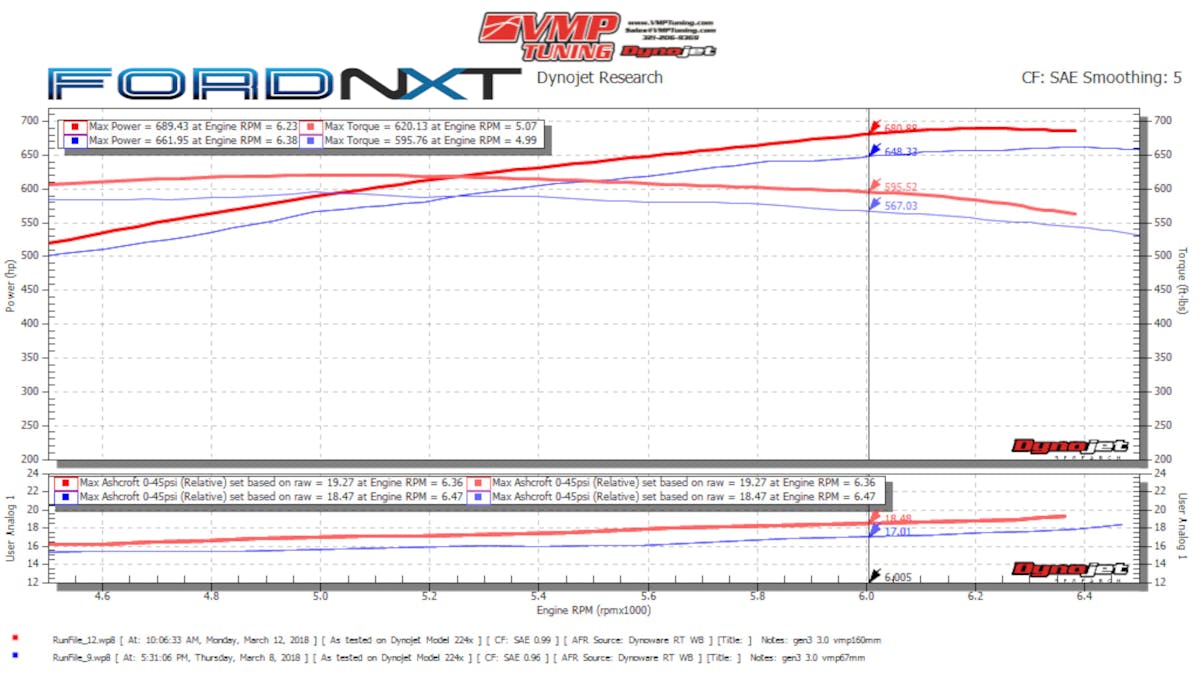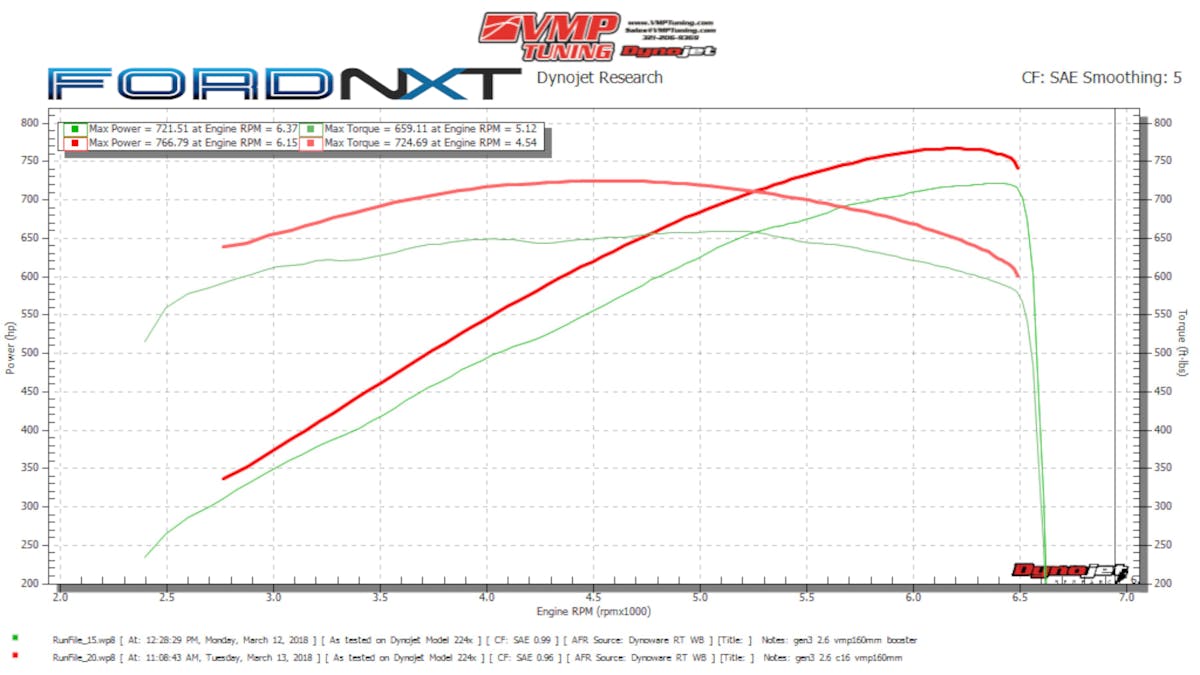Once the first examples of its Gen3 TVS supercharger arrived, VMP Performance put the 2.65-liter unit to the test immediately on the likes of a stock Coyote and a built 2013 Shelby GT500 with impressive results. However, the company jumped into the blower business with direct-replacement units for Shelbys, so VMP president Justin Starkey was eager to try the new unit on a stock, 5.4-liter GT500.
“In milder applications, the VMP Gen3 — with Eaton’s new 2650 rotors — shines as well; we’re finding it moves a ton of air without needing to be spun hard,” Justin Starkey of VMP Performance explained. “For the enthusiast looking to keep a stock engine alive for a long time, this means large pulley sizes, slower blower RPM, lower temps, and less chance of belt-slip issues.”
To prove that out, he bolted the new unit to a stock 2012 Shelby GT500, which still wears its cast factory exhaust manifolds and exhaust system right down to the factory catalytic converters. So configured and run on pump gas for most of the testing, it represented a great to see what a real-world street car would produce with VMP’s blower upgrade.
Justin started by baselining the combo. Then the VMP team installed a Gen2R supercharger with its companion TwinJet 67mm throttle body, colder spark plugs, a JLT Performance 123mm cold-air intake, an supplementary idler pulley, and an off-the-shelf VMP calibration.
“We made 658 rear-wheel horsepower with the Gen2R, which is a middle of the road number for a car with stock exhaust and no fine-tuning,” Justin said. “It took the smallest pulley we make, a 2.4-inch upper, to get 18 psi and 658 rear-wheel horsepower from the Gen2R.”
Then it was time to install the vaunted, 2.65-liter Gen3 TVS, but Justin started with the larger 3-inch blower pulley to test the efficiency of the new unit.

“We knew it would make more boost, everything else was left the same including the tune,” he said. “We used an adapter plate that we make to allow the VMP TwinJet 67mm throttle body to bolt onto the Gen3.”
The new head unit picked up power in that configuration, but really started to gain an advantage — over 30 horsepower and 40 lb-ft of torque — as the VMP crew installed a 2.8-inch pulley to spin the supercharger harder. However, there appeared to be more potential that could be unlocked with more airflow.
“I suspected the Gen3 needed more air, so we switched to the VMP 160mm single-blade throttle body, which we designed specifically for the Gen3,” Justin said. “At the same time we also went back to the 3.0-inch pulley so we could see if there were any gains to be had from opening up the Gen3, even with bigger pulley sizes.
The Gen3 moves so much air at a lower RPM that it will benefit from a larger throttle body much sooner than the older 2.3-liter based series. — Justin Starkey, VMP Performance
The huge, single-blade unit definitely fed the Gen3 with the sort of air it really needed to perform. Swapping the pulley and moving back to a 3-inch pulley still pushed the output higher.
“You will see lower air temps, and surprisingly, better fuel economy in some applications,” Justin said of the move to a bigger throttle body. “Restriction is the enemy of any compressor, and the Gen3 moves so much air at a lower RPM that it will benefit from a larger throttle body much sooner than the older 2.3-liter based series.”
The testing definitely proved that out with chunky gains delivered by the additional airflow.
“Up 28 horsepower and 25 lb-ft at the rear wheels with the same size pulley, we quickly found out the VMP Gen3 loves to breathe, picking up power and boost with the throttle body swap,” he added. “From here we really wanted to see how far we could push a totally stock GT500 with the new Gen3. We knew the factory manifolds and cats would be a huge restriction. They were already causing boost to spike artificially above 6,000 RPM, but it would also be a great way to see what the Gen3 is capable of producing.”
Justin continued to push the combo on 93-octane pump fuel by stepping down to the 2.6-inch blower pulley with continuing improvements, but things really jumped up when the VMP crew filled the tank with C16 race fuel, which allows pushing the timing values higher in the calibration.
“These gains are in line with what we would expect from race gas, even more power could be expected with E85,” Justin said. “Now, here’s where it gets interesting. With all the controversy on the internet regarding different correction factors, we decided to look at all of them. It was a cool Florida day (high of 65 degrees Fahrenheit), so the SAE numbers were corrected down to 766 rear-wheel horsepower. The common standard correction factor showed 790 rear-wheel horsepower. Finally, looking at the dyno numbers uncorrected showed 802 rear-wheel horsepower! This was what the car was actually making at that moment.”
It was certainly instructive to see the full range of testing, and look at how the correction factors come into play depending on the weather conditions. However, even if you don’t plan to push your car to 800 rear-wheel horsepower on race fuel, the Gen3 should serve you well because the efficiency it showed during this testing.
It definitely looks like the VMP Gen3 TVS is a power adder worth considering for a host of modern Mustangs.
You might also like
Giving Fox Dreams More Grip With A Complete BMR Suspension Upgrade
Project Fox Dreams is destined for a supercharged engine upgrade. To plant that power, we revamped its chassis and suspension with BMR.




















